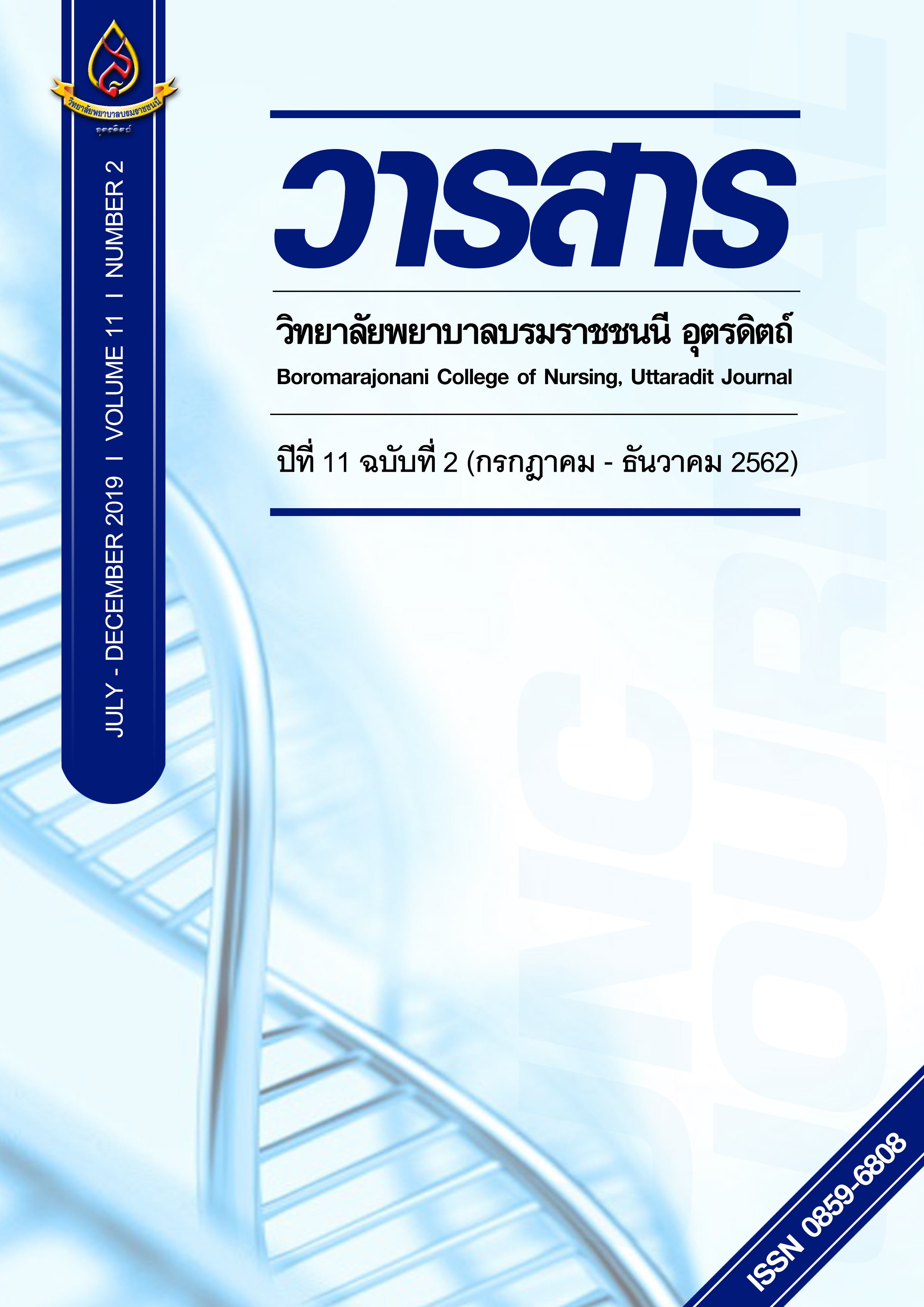ภาวะผู้นำด้านความปลอดภัยและการปฏิบัติงานด้านความปลอดภัยในองค์กรสุขภาพ: การทบทวนวรรณกรรมอย่างเป็นระบบ
Main Article Content
บทคัดย่อ
ภาวะผู้นำด้านความปลอดภัยส่งผลให้เกิดการปฏิบัติด้านความปลอดภัยของบุคลากรในทุกองค์กรที่มุ่งเน้นความปลอดภัย การศึกษานี้มีวัตถุประสงค์เพื่อสังเคราะห์ข้อมูลเชิงประจักษ์ภาวะผู้นำด้านความปลอดภัยและการปฏิบัติการด้านความปลอดภัยขององค์กรสุขภาพ สืบค้นงานวิจัยจากวารสารฐานข้อมูลในระดับชาติและนานาชาติ มีการตีพิมพ์เผยแพร่ในช่วง พ.ศ. 2552 – 2561 วิเคราะห์ข้อมูลคุณลักษณะงานวิจัยโดยใช้สถิติเชิงพรรณนา ได้แก่ จำนวนและร้อยละ ผลประเมินคุณภาพจากผู้ประเมิน 2 คน จำนวน 10 เรื่อง พบค่าความน่าเชื่อถือเท่ากับร้อยละ 82 ผลการทดสอบความสอดคล้องด้วยสถิติแคปปา พบว่า ไม่มีความแตกต่างอย่างมีนัยสำคัญทางสถิติ (k =.026, p =.83)
ผลการศึกษา พบว่า ภาวะผู้นำด้านความปลอดภัยที่มีการผสมผสานแนวคิดภาวะผู้นำมากกว่า 1 แนวคิด (n=5) และมีแนวคิดภาวะผู้นำด้านการเปลี่ยนแปลงเป็นแนวคิดร่วมมากที่สุด (n=6) มีการศึกษาถึงแนวคิดการปฏิบัติงานด้านความปลอดภัยในองค์กรสุขภาพที่ประกอบด้วยการมีส่วนร่วมด้านความปลอดภัยและด้านการปฏิบัติตามด้านความปลอดภัยเป็นองค์ประกอบมากที่สุด (n= 7) และพบว่าภาวะผู้นำด้านความปลอดภัยมีความสัมพันธ์และมีอิทธิพลโดยตรงต่อการปฏิบัติงานด้านความปลอดภัยในองค์กรสุขภาพมากที่สุด (n=6) จากผลการศึกษาแสดงให้เห็นว่าองค์กรด้านสุขภาพให้ความสำคัญกับแนวคิดภาวะผู้นำด้านความปลอดภัยและการปฏิบัติงานด้านความปลอดภัย แต่อย่างไรก็ตามควรมีการสนับสนุนให้มีการวิจัยเชิงทดลองและติดตามผลลัพธ์ในระยะยาวเพื่อให้ได้รูปแบบการพัฒนาคุณลักษณะภาวะผู้นำด้านความปลอดภัยในองค์กรสุขภาพซึ่งจะเป็นประโยชน์ต่อผู้บริหารองค์กรต่อไป
Article Details
บทความหรือข้อคิดเห็นใดใดที่ปรากฏในวารสารวิจัยการพยาบาลและวิทยาศาสตร์สุขภาพ เป็นวรรณกรรมของผู้เขียน ซึ่งบรรณาธิการหรือสมาคมศิษย์เก่า ไม่จำเป็นต้องเห็นด้วย และบทความที่ได้รับการตีพิมพ์เผยแพร่ถือเป็นลิขสิทธิ์ของวารสารวิจัยการพยาบาลและวิทยาศาสตร์สุขภาพ
References
2) Bernard, M. B. (1999). Two decades of research and development in transformational leadership. European Journal of Work and Organizational Psychology, 8(1), 9-32.
3) Berninghoff1, K. P., Cortes, V. J., Sprague, T.,Aye Z.C., Greiving, S.,Głowacki, W., & Sterlacchini, S. (2014). The connection between long-term and short-term risk management strategies for flood and landslide hazards: examples from land-use planning and emergency management in four European case studies. Retrieved (2018, September 2) from www.nat-hazards-earth-syst-sci.net/14/3261/2014/doi:10.5194/nhess-14-3261-2014
4) Cooper, M.D. (2010a). Safety leadership. Retrieved (2018, May) from www.behavioral- safety.com/behavior-based-safety-solution-center/safety-coaching-and-training/safety -leadership
5) Cohen, J. (1960). A coefficient of agreement for nominal scales. Educational and Psychological Measurement, 20(1), 37-46.
6) Jha, A.K., Larizgoitia, I., Waters, H.,& Bates, D.W. (2013). The global burden of unsafe medical care: analytic modelling of observational studies. BMJ quality & safety, 22(10), 809- 815.
7) Khazada, B., Naeem,S. & Butt, H. (2018). Impact of Transformational Leadership on Job Satisfaction and Patient Safety Outcomes in Health Sector of Pakistan. Journal of Health Education Research & Development. Retrieved (2018, August 30) from https://www.omicsonline.org/open-access/impact-of-transformational-leadership-on-
8) job-satisfaction-and-patient-safety-outcomes-in-health-sector-of-pakistan-2380-5439- 1000251-100458.html
Kmet, L M, Lee, R.C. & Cook, L.S. (2004). Standard quality assessment criteria for evaluating primary research papers from a variety of fields. Retrieved 2018, November 30) From https://www.ihe.ca/advanced-search/standard-quality-assessment-criteria-for evaluating-primary-research-papers-from-a-variety-of-fieldsCanada: Interpret Design Inc
9) Lee, Y.H. &Yang, C C. (2013). A Multi-Level of Patient Safety Culture Effect on Safety Performance: The Case of Nurse. Global Journal of Management And Business Research, [Sl.],. Retrieved (2018, February 10) from
https://journalofbusiness.org/index.php/GJMBR/article/view/942
10) Lievens, I., & Vlerick P. (2013). Transformational leadership and safety performance among nurses: the mediating role of knowledge-related job characteristics. Journal Advanced Nurse. Retrieved (2018, May 1 ) fromhttps://onlinelibrary.wiley.com/doi/abs/10.1111/jan.12229
11) Lun,C.J.,& Wahab ,S. R. A. (2017). The effects of safety leadership on safety performance in Malaysia. Saudi Journal of Business and Management Studies. Retrieved (2018, October 20) from https://scholarsmepub.com/
Molnar, M.M., Schwarzl, U. V. T., Hellgren J., Hasson H., & Tafvelin S.(2018). Leading for Safety: A Question of
12) Leadership Focus. Journal of Safety and Health at Work Retrieved (2018, July 1) from https://www.sciencedirect.com/science/article/pii/S2093791116302918
13) Mullen, J.E .& Kelloway, E.K. (2009). Safety leadership: A longitudinal study of the effects of
transformational leadership on safety outcomes. Journal of Occupational and Organizational Psychology. Retrieved (2018, June 20) from https://onlinelibrary.wiley.com/doi/pdf/10.1348/096317908X325313
14) Mattson, M., Hellgren, J., & Goransson, S. (2015). Leader communication approaches and patient safety: An integrated model. Journal of Safety Research. Retrieved (2018, October 25) from
https://www.sciencedirect.com/science/article/pii/S0022437515000201
15) Mullen, J., Kelloway, E. K.,& Teed, M.(2011). Inconsistent style of leadership as a predictor of safety Behavior. An International Journal of Work, Health & Organizations. Retrieved (2018, September 2) from
https://www.tandfonline.com/doi/abs/10.1080/02678373.2011.569200
16) Neal, A., & Griffin, M.A. (2006). A study of the lagged relationships among safety climate, safety motivation, safety behavior, and accidents at the individual and group levels. Journal of Applied Psychology, 91, 946-953.
17) Tengilimoglu, D., Celik, E., & Guzel A. (2016). The effect of safety culture on safety performance: intermediary role of job satisfaction. British Journal of Economics, Management & Trade. Retrieved (2018, September 2) from https://www.sciencedomain.org/abstract/16798
18) The Joanna Briggs Institute. (2016). New JBI levels of evidence. Retrieved (2016, May 1) From https://joannabriggs.org/jbi-approach.html#tabbed-nav=Levels-of-Evidence
19) Russell, R.F. (2001). The role of values in servant leadership. Leadership & Organization Development Journal, 22(2), 76-84.
20) Wu, T. C., Chen, C. H., & Li, C.C.(2008). A correlation among safety leadership, safety climate and safety performance. Journal of Loss Prevention in the process industries. 21(3) 307-318.

